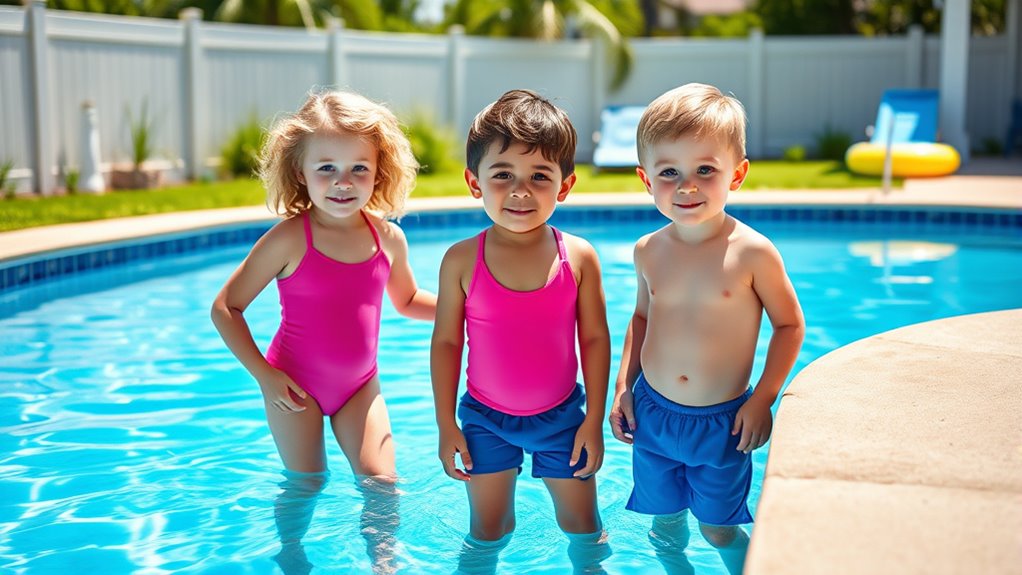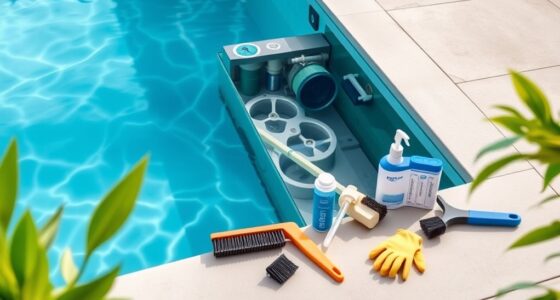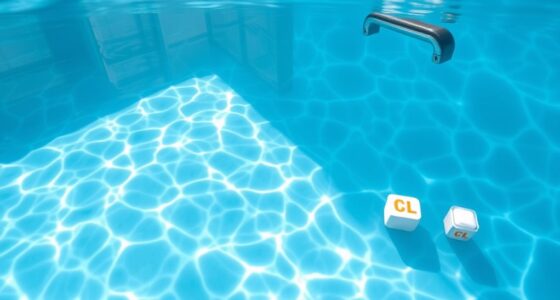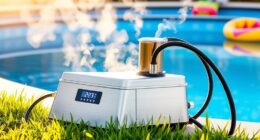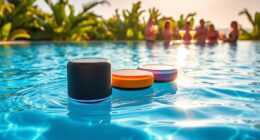To keep your kids safe around an endless pool, always supervise them closely and keep them within arm’s reach, especially beginners. Install a secure barrier or cover to prevent unauthorized access, and clear the area of toys and obstacles when not in use. Teach water safety basics, use life jackets for younger children, and regularly check equipment for hazards. If you want to guarantee thorough safety, there’s more essential advice to consider.
Key Takeaways
- Always supervise children closely and keep them within arm’s reach when near the pool.
- Install secure fencing, self-latching gates, and safety covers to prevent unauthorized access.
- Teach children water safety rules and swimming skills through qualified lessons.
- Avoid pool use during bad weather, especially thunderstorms, and immediately clear the pool if lightning occurs.
- Regularly inspect safety equipment, maintain proper water chemistry, and establish emergency protocols.
Always Supervise Children When They Are in or Near the Pool
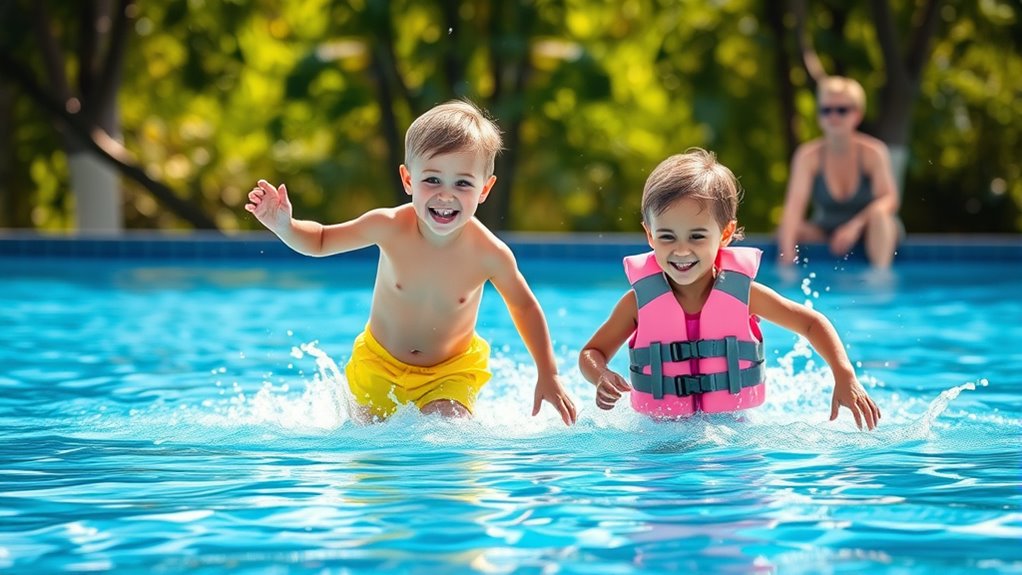
Always supervising children when they are in or near the pool is essential for preventing accidents. You need to stay attentive at all times, even if your child knows how to swim. Distractions like phones or conversations can divert your focus, increasing risk. Keep children within arm’s reach, especially younger ones or those still learning to swim. Establish clear rules about pool use and make sure your kids understand them. Never leave children unattended, even for a moment. Active supervision means watching continuously, not just glancing over now and then. Remember, accidents happen quickly, and your vigilant supervision can be the difference between fun and tragedy. By staying alert, you ensure your children enjoy the pool safely and responsibly. Regularly practicing pool safety measures helps reinforce proper behavior and awareness.
Install a Secure Barrier or Cover to Prevent Unauthorized Access
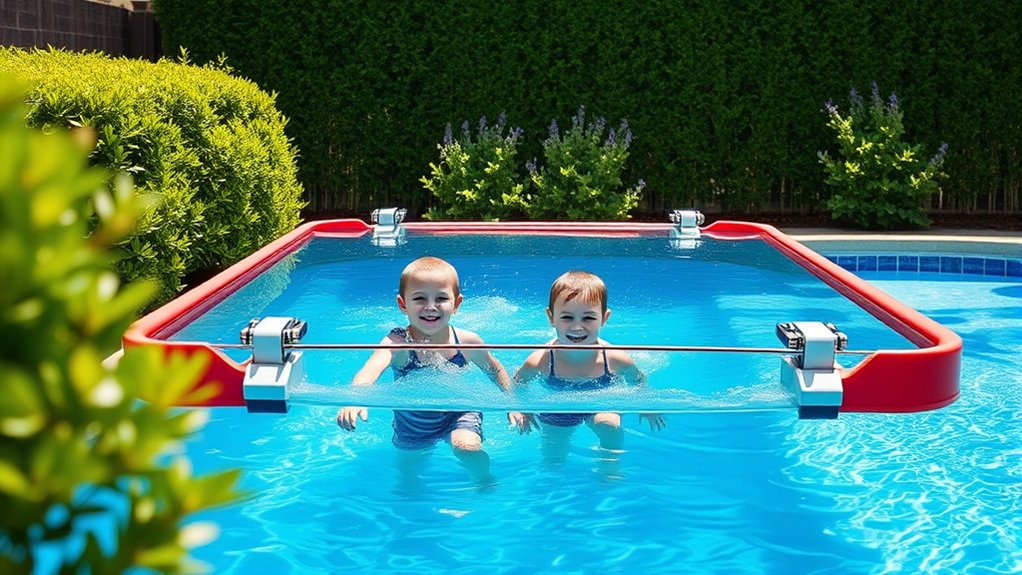
Installing a secure barrier or cover around your pool is one of the most effective ways to prevent children and unauthorized individuals from gaining access. A sturdy fence with a self-closing, self-latching gate creates a physical obstacle that keeps curious kids out when you’re not watching. Pool covers, especially safety covers, add an extra layer of protection, preventing accidental falls. Consider the table below to compare options:
| Barrier Type | Material | Key Benefit |
|---|---|---|
| Pool Fence | Vinyl, metal | High durability, visibility |
| Safety Cover | Mesh, solid cover | Prevents access, quick install |
| Alarm System | Sensors on gates | Instant alert for breaches |
| Locking Gate | Self-closing latch | Limits unauthorized entry |
| Enclosure | Complete structure | Maximum safety and privacy |
Additionally, understanding the contrast ratio of your projector can help ensure clear, vibrant images that captivate children during viewing.
Keep Pool Area Clear of Toys and Obstacles When Not in Use
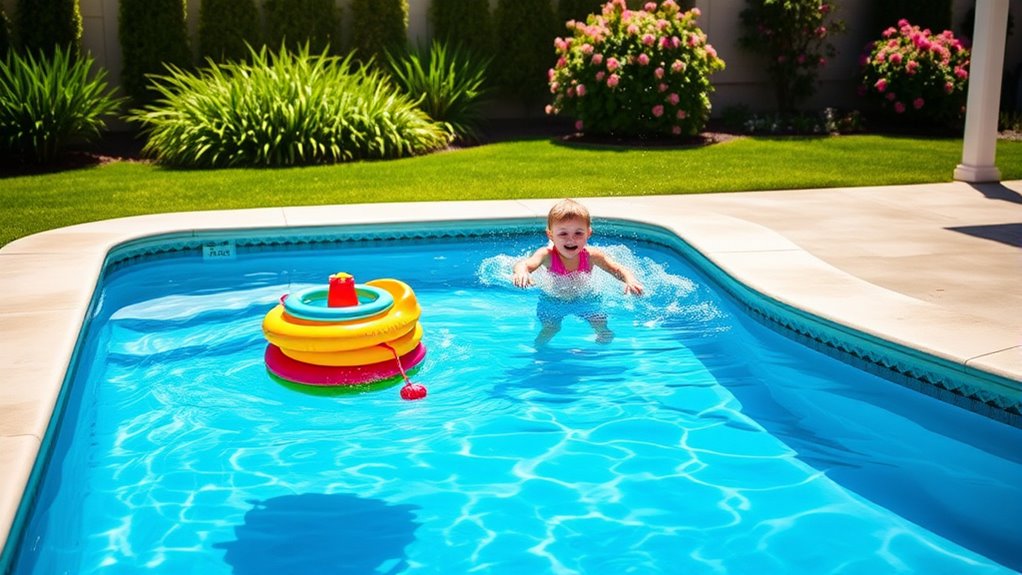
To keep the pool area safe, make sure toys are stored properly when not in use. Use a designated storage space to prevent tripping hazards. Regularly inspect the area to guarantee it stays clear of obstacles that could cause accidents. Additionally, consider childproofing the pool area to ensure young children cannot access the water unsupervised.
Designated Toy Storage
Keeping pool toys and obstacles in designated storage areas is essential for safety. When toys are left around the pool, they create tripping hazards or block clear pathways, increasing the risk of accidents. Establish a specific storage spot, like a waterproof bin or a nearby shed, where all toys and equipment should go after use. Make it a routine to return items immediately once playtime ends, reinforcing safe habits. Clearly communicate this rule to your children so they understand the importance of keeping the pool area tidy. Not only does this prevent injuries, but it also keeps the space organized and ready for safe use. Consistent storage practices help maintain a hazard-free environment for everyone.
Regular Area Inspections
Regularly inspecting the pool area helps guarantee it stays safe and free of hazards when not in use. You should check that toys, floaties, and other objects are stored away properly, preventing tripping or slipping accidents. Clear the surrounding space of any obstacles that could cause falls or injuries if someone steps or trips over them. Look for any damage to fencing, gates, or safety covers, and repair or replace them promptly. Keep the area dry and clean, removing leaves, dirt, or debris that could make the surface slippery. Regular inspections also help identify potential hazards early, such as loose tiles or unstable furniture. By maintaining a tidy and hazard-free environment, you ensure the pool area remains safe for your kids and family, even when no one’s swimming.
Ensure Proper Pool Equipment and Safety Devices Are in Place
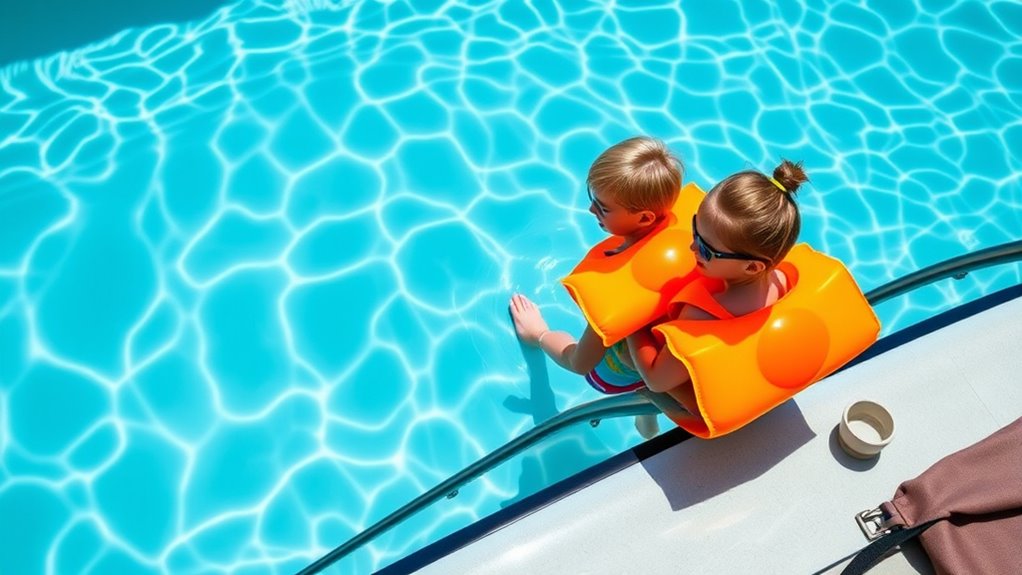
Make sure your pool has sturdy safety barriers to prevent unsupervised access. Installing pool alarms can alert you immediately if someone enters the water unexpectedly. Regularly check and maintain all equipment to keep safety devices functioning properly. Additionally, ensure proper airflow around any pool air purification units to maintain optimal air quality and safety. proper airflow around equipment
Check Safety Barriers
Ensuring that safety barriers are in place is essential for preventing accidents around the pool. You should regularly inspect fences, gates, and covers to make sure they are secure and in good condition. Check that gates latch automatically and remain locked when not in use. Make sure there are no gaps or holes in fences that a child could squeeze through. If your pool has a safety cover, verify it’s properly installed and in good repair. Keep safety barriers at the appropriate height and strength to prevent climbing. Maintaining these barriers reduces the risk of unsupervised access and keeps your kids safe. Always review and update safety barriers periodically, especially after weather events or renovations, to ensure they remain effective.
Install Pool Alarms
Installing pool alarms adds an extra layer of protection by alerting you immediately if someone enters the water without permission. These alarms can be placed on doors leading to the pool area, windows, or directly in the water itself. When installed correctly, they provide quick notifications, giving you time to respond before a dangerous situation occurs. Make sure to choose alarms suitable for your pool type and follow the manufacturer’s instructions carefully. Test alarms regularly to ensure they work properly. Keep alarm sounds audible from all main areas of your home, so you’re always aware of any activity near the pool. Remember, alarms are an essential safety tool, but they should complement other safety measures like barriers and supervision. High critical acclaim and box office success can indicate reliable and effective safety equipment options.
Maintain Equipment Regularly
Regularly inspecting and maintaining your pool equipment and safety devices is essential to keeping everyone safe. Proper upkeep guarantees everything functions correctly when needed most. Here’s what you should do:
- Check safety devices like pool covers, alarms, and fences for damage or wear, replacing or repairing as needed.
- Test pool pumps, filters, and heaters weekly to ensure they operate efficiently and shut off properly.
- Clean skimmers and remove debris regularly to prevent clogs and maintain water quality.
Teach Kids Basic Water Safety and Swimming Skills
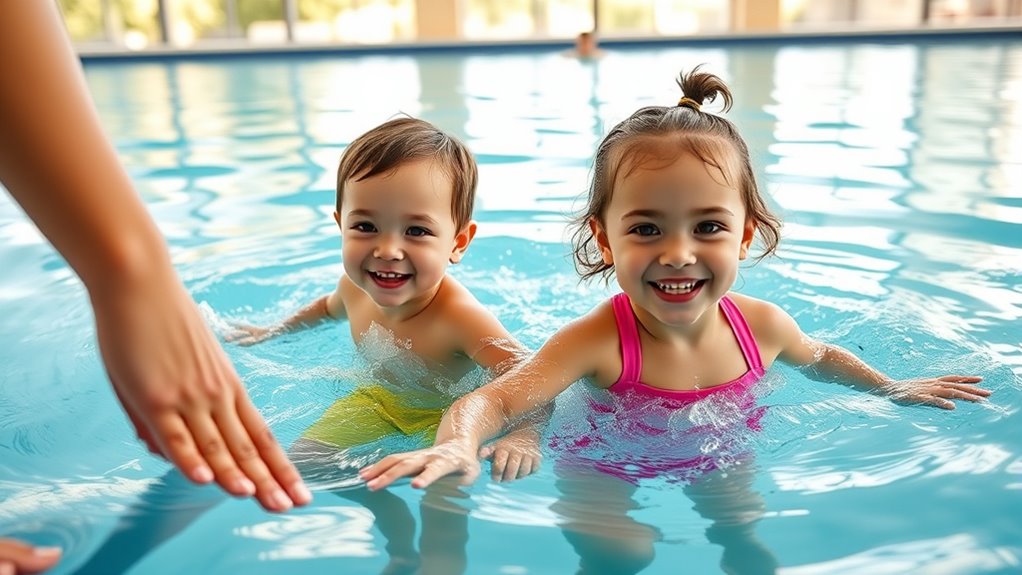
Teaching kids basic water safety and swimming skills is essential for preventing accidents and building their confidence in the water. Start by enrolling them in age-appropriate swimming lessons with qualified instructors. Focus on teaching them how to float, tread water, and safely enter and exit the pool. Make sure they understand that they should never swim alone, even if they’re confident swimmers. Reinforce the importance of staying within designated areas and alerting you if they feel uncomfortable or tired. Practice consistent safety habits, like never running around the pool and avoiding risky behaviors. Building their skills and awareness not only reduces the chance of accidents but also encourages a lifelong love of swimming and water activities. Additionally, teaching children water safety rules early helps instill responsible behavior and awareness of potential dangers in aquatic environments.
Set Clear Rules for Pool Use and Enforce Them Consistently
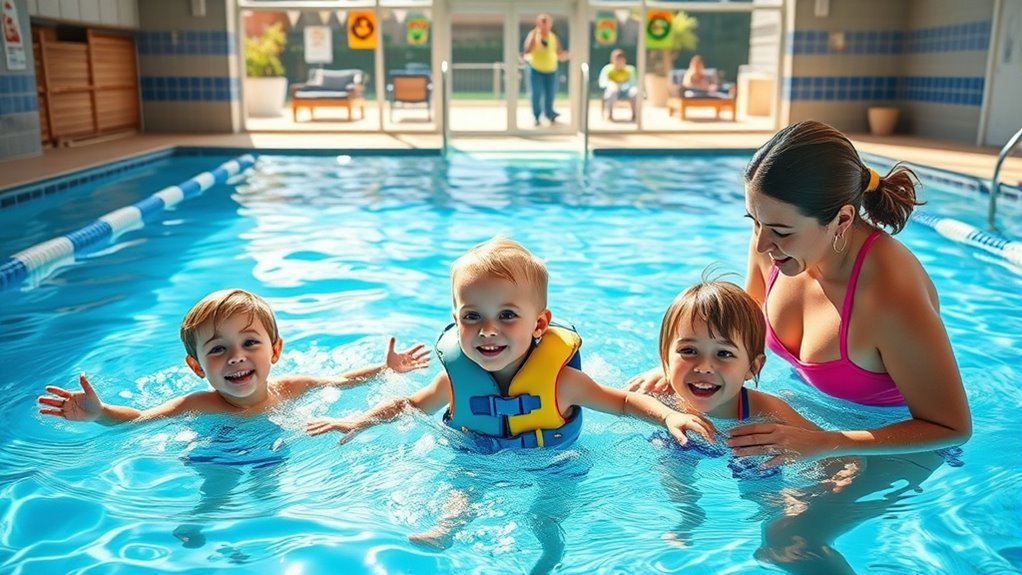
You need to set clear rules about who can use the pool and when, so kids understand what’s expected. Always supervise them closely to make certain rules are followed and safety is maintained. Establish age restrictions to prevent younger children from accessing the pool without proper oversight.
Establish Age Restrictions
Setting clear age restrictions for pool use helps guarantee kids stay safe and understand their limits. By establishing these boundaries, you reduce risks and promote responsible behavior. To do this effectively:
- Determine appropriate age limits based on your child’s swimming skills and maturity.
- Communicate these rules clearly, explaining why certain ages can or can’t use the pool alone.
- Enforce the restrictions consistently, ensuring older kids understand they can’t bypass rules or supervise younger siblings.
Maintain Supervision Always
To keep kids safe around the pool, constant supervision is essential, and clear rules must be established and enforced without exception. Always watch your children when they’re in or near the water, never leave them unattended, even for a moment. Set specific guidelines, such as no running, pushing, or diving in shallow areas, and ensure kids understand these rules. Reinforce safety rules consistently, and address any unsafe behavior immediately. Designate a responsible adult to supervise at all times, avoiding distractions like phones or conversations. If kids are swimming, stay within arm’s reach if they’re young or inexperienced. By maintaining vigilant supervision and enforce rules, you create a safer environment that minimizes the risk of accidents.
Avoid Pool Use During Bad Weather or When Unsure of Conditions
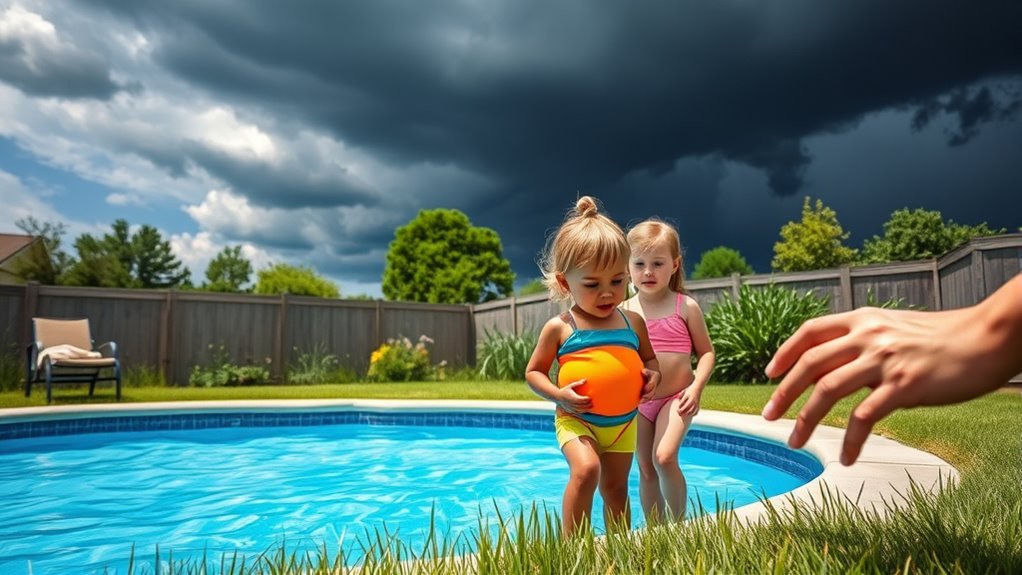
Bad weather can quickly turn dangerous around a pool, so it’s essential to avoid swimming during storms, heavy rain, or strong winds. Conditions can change rapidly, making it unsafe for kids to be in or near the water. Always check the weather forecast before pool use. If you notice any of these signs, clear the pool immediately:
- Lightning or thunder nearby
- Heavy rain or hail
- Strong winds or dark storm clouds
Never hesitate to postpone swimming if you’re unsure about the weather. Safety comes first, and waiting until conditions improve reduces the risk of accidents or injuries. Keep kids out of the water until you’re confident it’s safe again. Better safe than sorry when it comes to pool safety. Additionally, being aware of weather-related risks helps you make informed decisions to protect your children.
Maintain Proper Pool Water Quality and Chemical Levels
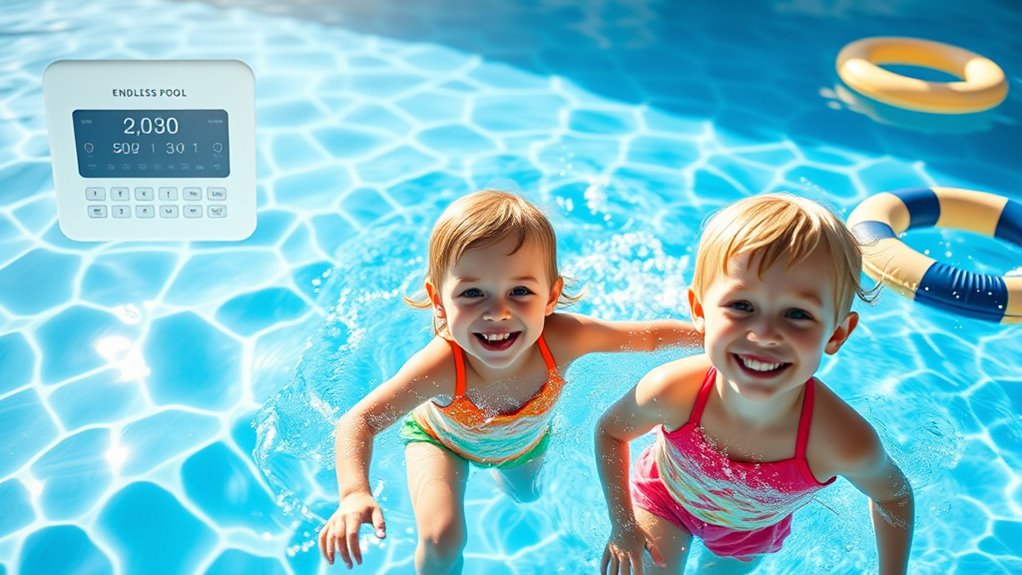
Making certain the pool water stays clean and safe is just as important as checking the weather before swimming. You need to regularly test the water’s pH, chlorine, and alkalinity levels using a testing kit. Keep pH between 7.2 and 7.8 to prevent skin irritation and equipment damage. Maintain proper chlorine levels to kill bacteria and algae, usually between 1 and 3 ppm. If levels are off, add the appropriate chemicals and retest after a few hours. Run the filter daily to circulate and filter debris. Regularly skim the surface and vacuum the bottom to keep the water clear. Consistent maintenance prevents illnesses and keeps the pool inviting for your kids. Staying vigilant about water quality ensures a safe, healthy swimming environment. Incorporating regular water testing can help detect imbalances early and ensure optimal safety.
Establish a Safety Protocol for Emergency Situations
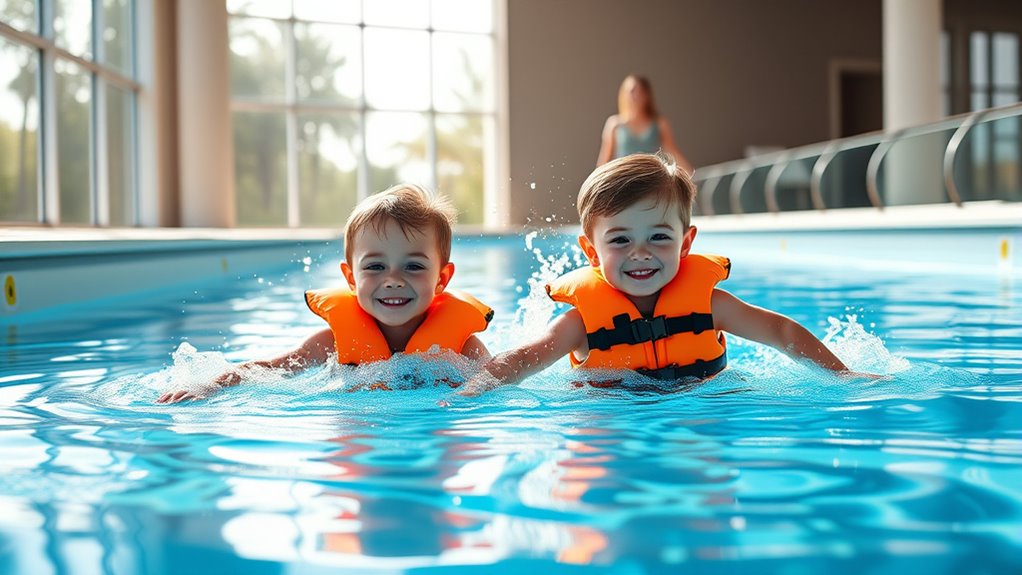
Having a clear safety protocol in place is essential for responding quickly and effectively during emergencies. You should prepare your family by establishing specific steps to follow if an incident occurs. First, assign roles so everyone knows what to do—who calls emergency services, who provides first aid, and who keeps others safe. Second, keep emergency contact numbers visible near the pool area, including local emergency services and a trusted neighbor. Third, conduct regular drills to practice these procedures, ensuring that everyone stays calm and knows their role. Fourth, familiarize yourself and your children with pool safety rules and potential hazards to prevent accidents before they happen. By practicing and communicating these steps, you minimize panic and delay, ensuring that help arrives swiftly and that your kids stay safe in any emergency.
Limit Pool Access to Children of Appropriate Age and Skill Level
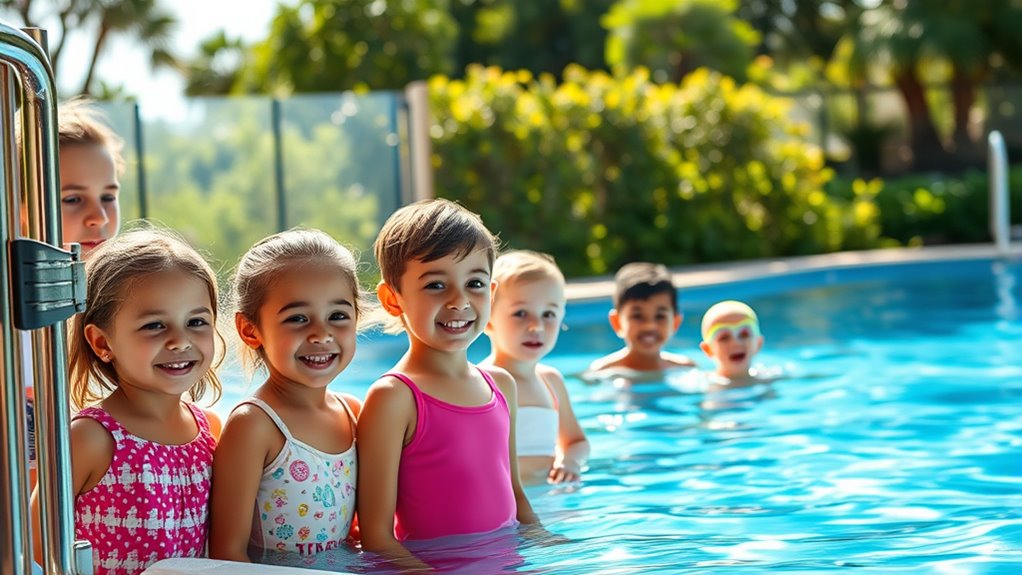
Establishing a safety protocol helps your family respond swiftly during emergencies, but preventing those situations starts with controlling who has access to the pool. You should only allow children of appropriate age and skill level to enter the water. Younger or inexperienced kids need close supervision and should not have unrestricted access. Set clear boundaries, such as a locked gate or alarm, to prevent accidental entry. Assess each child’s swimming ability before granting access, ensuring they can handle the water safely. Avoid letting children who aren’t confident swimmers or who haven’t received proper instruction near the pool unsupervised. By limiting access based on skill level, you reduce the risk of accidents and help build your child’s confidence gradually, creating a safer environment for everyone. Additionally, understanding eye patch benefits can be useful for parents considering eye health routines for their children, especially if they experience eye strain from screen time or other activities.
Use Life Jackets or Floatation Devices for Beginners or Younger Kids

Using life jackets or flotation devices is essential when supervising beginners or younger children around the pool. They provide an extra layer of safety and help children stay afloat. To maximize protection, keep these tips in mind:
- Ensure the device fits properly—snug but comfortable.
- Choose Coast Guard-approved flotation devices designed for children.
- Always supervise children closely when they wear flotation devices, never rely solely on them.
Regularly Inspect Pool Equipment and Surroundings for Hazards
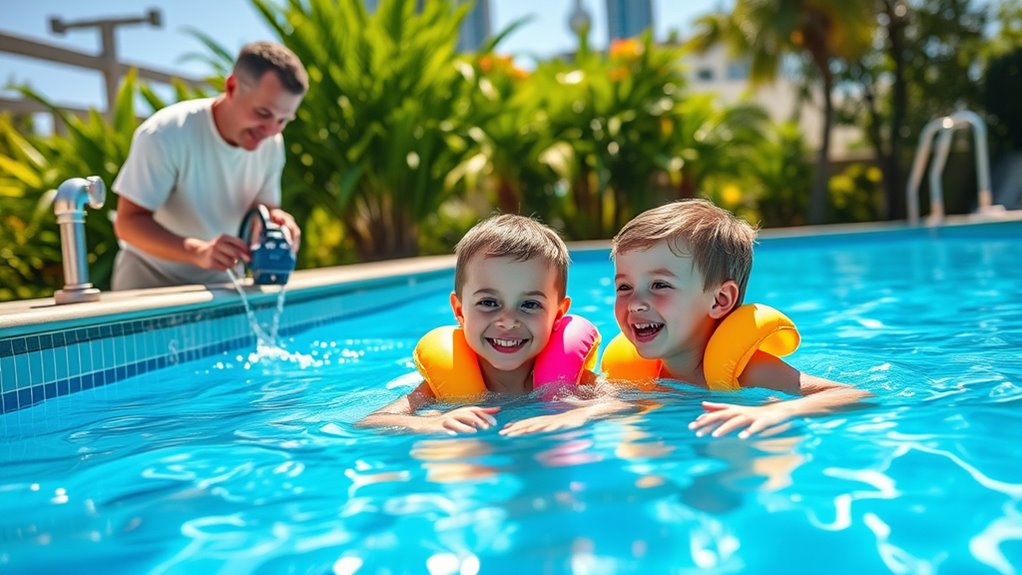
Regularly inspecting your pool equipment and surroundings is essential to maintaining a safe swimming environment. You should check for damaged or loose parts, such as filters, pumps, and ladders, to prevent accidents. Also, look around the pool area for hazards like sharp objects, debris, or slippery surfaces that could cause slips or injuries. Create a routine to ensure nothing gets overlooked.
| Equipment Checks | Surrounding Hazards |
|---|---|
| Inspect filters and pumps for leaks or damage | Remove debris, leaves, and trash |
| Tighten loose fittings and bolts | Secure or repair slippery surfaces |
| Test safety alarms and covers | Check fencing and gates for stability |
Frequently Asked Questions
How Can I Train My Child to Recognize Pool Hazards?
You can train your child to recognize pool hazards by teaching them to identify dangerous situations like slippery surfaces, deep water, and unguarded areas. Use simple language, demonstrate safe behavior, and encourage questions. Practice safety drills regularly, such as what to do if they fall in or see someone struggling. Reinforce these lessons consistently, and always supervise their activities around the pool to guarantee they stay alert and cautious.
What Are the Best Signs to Indicate Water Safety Rules?
You should use clear, visible signs with bold text and bright colors to indicate water safety rules. Include simple messages like “No Running,” “Shallow Water,” and “Always Supervise.” Place signs at eye level near the pool entrance and throughout the area. Use icons or pictures to help kids understand the rules easily. Regularly remind your children of these signs to reinforce safe behavior around the water.
How Often Should Pool Safety Equipment Be Inspected?
You should inspect your pool safety equipment monthly, like tuning a fine instrument to guarantee it’s in perfect harmony. Regular checks catch issues before they become hazards, so you can act swiftly if needed. Look for signs of wear, corrosion, or damage on items like life rings, pool alarms, and rescue hooks. Consistent inspections keep safety gear ready for action, creating a secure environment where kids can enjoy the water confidently.
When Should I Consider Professional Safety Training for My Kids?
You should consider professional safety training for your kids as soon as they are confident swimmers or when they start using the pool regularly. If your children are young or not yet proficient in swimming, it is crucial to enroll them early. Professional training helps kids learn vital skills, understand safety rules, and build confidence. Regular refresher courses are also beneficial, ensuring your kids stay prepared and safe around the pool at all times.
Are There Specific Safety Measures for Kids With Special Needs?
You might wonder if there are special safety measures for kids with special needs, and the answer is yes. It’s vital to tailor safety rules to your child’s unique abilities and challenges. Supervise closely, guarantee constant communication, and consider specialized safety equipment. Consult with professionals to develop a personalized plan, and always stay vigilant. Your proactive approach can make a significant difference in keeping your child safe and confident in the pool.
Conclusion
By following these safety rules, you can critically reduce the risk of accidents around the pool. Did you know that drowning is the leading cause of accidental death for children under five? Staying vigilant, installing proper barriers, and teaching kids water safety are essential steps to keep your little ones safe. Remember, a proactive approach guarantees everyone can enjoy the pool safely and confidently. Keep safety your top priority every time your kids swim.
